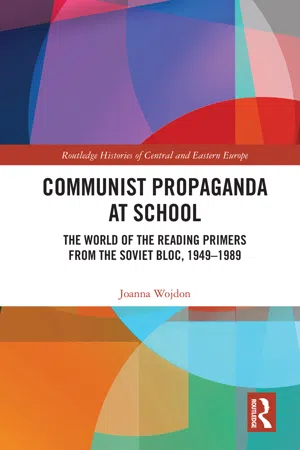
Communist Propaganda at School
The World of the Reading Primers from the Soviet Bloc, 1949-1989
- 168 pages
- English
- ePUB (mobile friendly)
- Available on iOS & Android
Communist Propaganda at School
The World of the Reading Primers from the Soviet Bloc, 1949-1989
About this book
Communist Propaganda at School is based on an analysis of reading primers from the Soviet bloc and recreates the world as presented to the youngest schoolchildren who started their education between 1949 and 1989 across the nine Eastern European countries. The author argues that those first textbooks, from their first to last pages, were heavily laden with communist propaganda, and that they share similar concepts, techniques and even contents, even if some national specificities can be observed.
This volume reconstructs the image of the world presented to schoolchildren in the first books they were required to read in their school life, and argues that the image was charged with communist propaganda. The book is based on the analysis of over sixty reading primers from nine countries of the Soviet bloc: Albania, Bulgaria, Czechoslovakia, the German Democratic Republic, Hungary, Poland, Romania, the Soviet Union and Yugoslavia from the period.
Written with simplicity and straightforwardness, this book will be a valuable resource, not only to international academics dealing with the issues of propaganda, censorship, education, childhood and everyday life under communism in Eastern and Central Europe, but can also academics dealing with education under communism or with the content of primary education. It also brings educational experiences of the Soviet bloc to international researchers, in particular to researchers of education under totalitarian and authoritarian regimes.
Frequently asked questions
- Essential is ideal for learners and professionals who enjoy exploring a wide range of subjects. Access the Essential Library with 800,000+ trusted titles and best-sellers across business, personal growth, and the humanities. Includes unlimited reading time and Standard Read Aloud voice.
- Complete: Perfect for advanced learners and researchers needing full, unrestricted access. Unlock 1.4M+ books across hundreds of subjects, including academic and specialized titles. The Complete Plan also includes advanced features like Premium Read Aloud and Research Assistant.
Please note we cannot support devices running on iOS 13 and Android 7 or earlier. Learn more about using the app.
Information
1 The wide world—the homeland
Between patriotism and communism
What is the homeland?
Table of contents
- Cover
- Half Title
- Series
- Title
- Copyright
- Contents
- Introduction: why reading primers? Why politics?
- 1 The wide world—the homeland: between patriotism and communism
- 2 The wide world—the development of technology and civilizational transformations
- 3 The world a little closer—adults
- 4 The world closest to children—school
- 5 Children in private life
- 6 Holidays
- Conclusion
- Bibliography
- Index